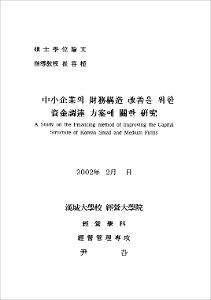中小企業의 財務構造 改善을 위한 資金調達 方案에 關한 硏究
= (A) Study on the Financing method of Improving the Capital Structure of Korean Small and Medium Firms
- Files in This Item:
-
-
Download
 000000066415.pdf
기타 데이터 / 3.06 MB / Adobe PDF
000000066415.pdf
기타 데이터 / 3.06 MB / Adobe PDF
-
Items in Repository are protected by copyright, with all rights reserved, unless otherwise indicated.